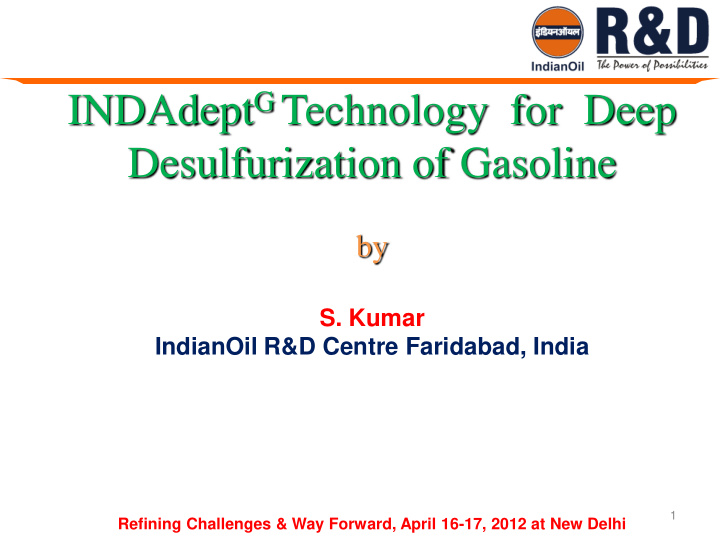



INDAdept G Technology for Deep Desulfurization of Gasoline by S. Kumar IndianOil R&D Centre Faridabad, India 1 Refining Challenges & Way Forward, April 16-17, 2012 at New Delhi
Issues in producing ULSG Options for Gasoline Desulph. Overview INDAdpt G Process Breakthrough Curve SO 2 Removal options Present status Summary
Iss ssue ue in producing ucing ULSG SG Minimum octane loss Minimum yield loss Minimum hydrogen consumption Capability to economically produce ULSG Conventional hydrotreating results in saturation of total olefins and higher octane loss
Op Option tions s for Ga Gasoli oline ne Des esulphu ulphuriza rizatio tion Achieve desulphurization with min. octane loss Separate octane contributors (LCN) by fractionation followed by HDS of remaining stream (HCN) - (Selective HDS) Compensate for the octane loss due to HDS by isomerization of saturated hydrocarbons - (Non-selective HDS) Adsorption (physical/ reactive) TECHNOLOGIES: PrimeG, OATS, SCANfining, CDHydro, ISAL,OCTGAIN, S-Zorb, INDAdept
INDAde Adept pt Process cess Fea eatur ures es Ideal for deep desulphurisation H 2 of gasoline/ diesel N 2 Air Proprietary Diesel adsorbent in hydrogen environment ‘S’ removed by cleavage of 1 2 C-S bond followed by reactive adsorption Two reactors operated in swing mode of adsorption and Adsorption Regeneration regeneration Adsorbent regenerated by oxidation of ‘S’ to SO 2 in presence of lean air- nitrogen 5 mixture
INDAde Adept pt Process ocess H 2 O 2
IND NDAde Adept pt G Process cess Fee eed/ d/Prod oduc uct t Prop oper erti ties es: Ideal for S reduction from 1000 to < 10 ppm RON reduction of 1-2 units H 2 consumption ~ 0.2 wt% Suitable for treating Coker/ FCC gasoline Employs single reaction step 7
cess IND NDAde Adept pt G Process Flow Diagram am Feed H 2 Reactor Recycle Compressor Separator Lt. Gases Flash Drum Product
cess IND NDAde Adept pt G Process Regen ener eration ion Flow Diagram am Make-up Air O 2 /CO 2 /CO Analyzers N 2 N 2 /O 2 H 2 / HC Analyzers Recycle gas N 2 /H 2 Make-up H 2 Water wash column Activation Separator Make-up Water Scrubber/SRU Water Caustic Combustion Separator Make-up Caustic/ Amine Flare H 2 / HC/ O 2 Analyzers Purging Fuel gas CBD Depressurization Separator Feed Storage
INDAdept G Process Regeneration Cycle Automatic Reactor swing mechanism & necessary safety interlocks Oxidation & activation steps conducted with compositions below lower inflammability limit. Further purging introduced before these steps Typical Regeneration Cycle (4-8 days, Temp : 400 – 500 0 C) 10
cess IND NDAde Adept pt G Process Reac actor tor swing ng ope peratio tion n HC/H 2 / O 2 Analyzers Feed/ H 2 HC/H 2 / O 2 Analyzers N 2 Adsorption N 2 /O 2 Activation N 2 /H 2 Combustion Purging H 2 / HC/ O 2 Analyzers Depressurization
Br Brea eakt kthr hrough ough Cu Curve e for or Gasoline asoline De Desul ulfu furiz rizatio tion Gasoline Desulphurization 80 Feed = 60% Coker Gasoline + 40% FCC Gasoline 70 Feed 'S' = 1080 ppm Feed Olefins = 26.5 wt% 60 50 S (ppm) 40 30 20 10 0 0 20 40 60 80 100 120 140 160 180 200 Time on Stream (Hrs)
SO 2 Removal/ Disposal Options Caustic Scrubber Integration with SRU SO 2 Containg gas stream from INDAdept 13
INDAdept Process Present Status Process developed after Extensive pilot plant data generated during last 7 years Scale-up & Commercialization along with Design & Engg. Consultant (EIL ) Adsorbent scale up & commercialization with Catalyst Manufacturer (Sud-Chemie India Ltd.) Demonstration unit of 35 TMTPA is under consideration in one of IOC’s Refineries for reduction of sulfur content in Heavy FCC gasoline from 1000 to 10 ppm 14
Su Summar mmary Lower consumption of H 2 (0.12 -0.25 % of feed) in INDAdept G Process can be used by refineries to meet EURO- IV and EURO-V specifications Lower Plant & Machinery cost Lower octane loss 15
16
Recommend
More recommend